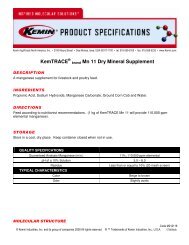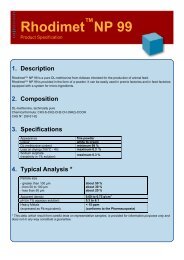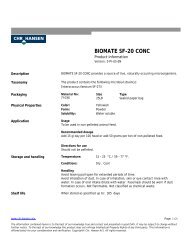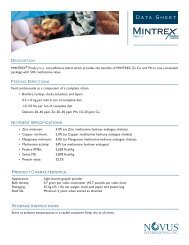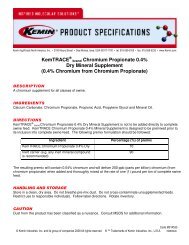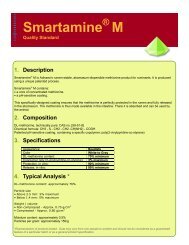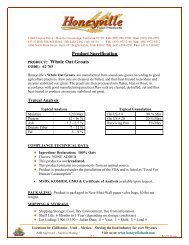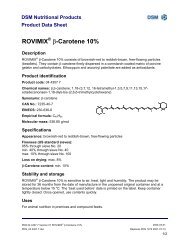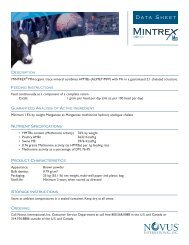Rabonï 7.76 Oral Larvicide Premix CAUTION - TPi
Rabonï 7.76 Oral Larvicide Premix CAUTION - TPi
Rabonï 7.76 Oral Larvicide Premix CAUTION - TPi
You also want an ePaper? Increase the reach of your titles
YUMPU automatically turns print PDFs into web optimized ePapers that Google loves.
Revision Date 06-05-03 13ABCDRabon® <strong>7.76</strong> <strong>Oral</strong><strong>Larvicide</strong> <strong>Premix</strong>To prevent the development of Horn Flies, Face Flies, House Fliesand Stable Flies in the manure of treated cattle; House Flies in themanure of treated swine, House Flies and Stable Flies in the manureof treated horses and House Flies in the manure of treated mink.Active IngredientBy WeightTetrachlorvinphos: (CAS #22248-79-9) . . . . . . . . . . . . . . . . <strong>7.76</strong>%*Other Ingredients . . . . . . . . . . . . . . . . . . . . . . . . . . . . . . . . . 92.24%**Total . . . . . . . . . . . . . . . . . . . . . . . . . . . . . . . . . . . . . . . . . . .100.00%* RABON Insecticide – Contains 35 grams of RABON per pound.**Refers only to ingredients which are not larvicidal.Keep Out of Reach of Children<strong>CAUTION</strong>PRE<strong>CAUTION</strong>ARY STATEMENTSHazards to Humans and Domestic Animals<strong>CAUTION</strong>Harmful if swallowed or absorbed through the skin. Causes moderate eye irritation. Avoid contact with eyes, skin or clothing.Prolonged or frequently repeated skin contact may cause allergic reaction in some individuals.Personal Protective EquipmentMixers and Handlers must wear:- long-sleeved shirt and pants- shoes and socks- chemical resistant glovesUser Safety RequirementsFollow manufacturer’s instructions for cleaning/maintaining PPE. If no such instructions for washables, use detergent and hot water.Keep and wash PPE separately from other laundry.User Safety RecommendationsUsers should wash hands before eating, drinking, chewing gum, using tobacco or using the toilet.Users should remove clothing immediately if pesticide gets inside. Then wash thoroughly and put on clean clothing.Users should remove PPE immediately after handling this product. Wash the outside of gloves before removing. As soon as possible,wash thoroughly and change into clean clothing.FIRST AIDIf swallowed • Call a poison control center or doctor immediately for treatment advice.• Have person sip a glass of water if able to swallow.• Do not induce vomiting unless told to do so by a poison control center or doctor.• Do not give anything by mouth to an unconscious person.If on skin or clothing • Take off contaminated clothing.• Rinse skin immediately with plenty of water for 15-20 minutes.• Call a poison control center or doctor for treatment advice.If in eyes • Hold eye open and rinse slowly and gently with water for 15-20 minutes.• Remove contact lenses, if present, after the first 5 minutes, then continue rinsing eye.• Call a poison control center or doctor for treatment advice.HOT LINE NUMBERContains an organophosphate that inhibits cholinesterase.Have the product container or label with you when calling a poison control center or doctor, or going for treatment. You may alsocontact 1-800-821-7467 for emergency medical treatment information.NOTE TO PHYSICIANSThis product is a cholinesterase inhibitor. If symptoms of cholinesterase inhibition are present, atropine sulfate by injection isantidotal. 2-PAM is also antidotal and may be administered, but only in conjunction with atropine.Environmental HazardsThis pesticide is toxic to fish. Do not contaminate water when disposing of equipment wash water.See side panel for additional precautionary statements.Net Weight 40 PoundsKMG-Bernuth, Inc. EPA Reg. No. 61483-48Houston, TX. 77036EPA Est. No. 4691-KS-01Warranty and Limitation of DamagesSeller warrants that this material conforms to its chemical description and is reasonably fit for the purposes stated on the label when usedin accordance with directions under normal conditions of use and Buyer assumes the risk of any use contrary to such directions. Sellermakes no other express or implied warranty, including any other express or implied warranty of Fitness or of Merchantability,and no agent of Seller is authorized to do so except in writing and with specific reference to this warranty. In no event shallSeller’s liability for any breach of warranty exceed the purchase price of the material as to which a claim is made.Directions for UseIt is a violation of Federal law to use this product in a manner inconsistent with its labeling.Storage & DisposalDo not contaminate water, food or feed by storage or disposal.Storage: Store in a dry place in original container.Disposal: Completely empty bag into mixing equipment. Then dispose of empty bag in a sanitary landfill or by incineration or ifallowed by State and local authorities by burning. If burned, stay out of smoke. Wastes resulting from the use of this product may bedisposed of on site or at an approved waste disposal facility.General InformationTo prevent the development of horn flies, face flies, house flies, and stable flies in the manure of treated cattle; house flies in themanure of treated swine; house flies and stable flies in the manure of treated horses; and house flies in the manure of treated mink.
Revision Date 06-05-03 14Rations containing this product may be fed up to slaughter and to lactating dairy cows without withholding themilk from market during or after treatment.Start feeding RABON larvicidal feeds early in the spring before flies begin to appear and continue feedingthroughout the summer and into the fall until cold weather restricts fly activity.When fed, this product passes through the digestive system into the animal’s manure where it kills fly larvae oncontact shortly after fly eggs hatch.It prevents the development of fly larvae in the manure of treated animals, but is not effective against existingadult flies.In some cases, supplemental fly control measures may be needed in and around cattle lots and barns to controladult house flies and stable flies which can breed not only in manure but in other decaying vegetable matter or silageon the premises.In order to achieve optimum fly control, this product should be used in conjunction with other goodmanagement and sanitation practices.This product will mix uniformly in feeds when standard mixing procedures are followed. Thus, usual problemsthat are common to all feed preparation and which cause stratification, such as excessive free-fall or excessivehandling, are to be avoided. It is recommended that appropriate preblending techniques be employed to assureadequate distribution throughout the feed mix. The premix should be preblended with ground grain, proteinsupplements, mineral mixes, etc. before being added to roughages such as chopped hay or silage. Mixing time shouldbe adequate to assure uniform dispersion. Optimum performance can be assured only if this product is disperseduniformly with the feedstuff at the recommended level. Common feed mixing equipment (i.e. vertical mixer,horizontal blender, mixer/feed truck) may be used to prepare formulated feeds.General Precautions and RestrictionsDo not apply this product in a way that will contact workers or other persons, either directly or through drift. Onlyprotected handlers may be in the area during application. Feeds prepared with this product should not be pelleted norbe mixed with feeds containing predominantly pellets. Further, this product should not be mixed in liquid feedsupplements.Application InstructionsThis product may be fed to cows, swine, and mink up to slaughter and to lactating cows.CattleIn a Concentrate Feed – Roughage Fed SeparatelyThis product can be used to prepare concentrate feeds that will provide 70 mg of RABON per 100 pounds ofbody weight daily.To prepare a larvicidal concentrate feed, mix this product according to the amount of concentrate to be fed peranimal per day. Use the following table as a guide for determining the proper mixing rate.MIXING GUIDEPounds of Concentrate RABON in the Concentrate Pounds of RABON <strong>7.76</strong>Consumed per Animal mg/lb % <strong>Oral</strong> <strong>Larvicide</strong> <strong>Premix</strong> perper Day Ton of Concentrate0.5 1584 0.35 90.01.0 792 0.18 45.01.5 528 0.12 30.02.0 396 0.087 22.55.0 159 0.035 9.010.0 79 0.018 4.515.0 53 0.012 3.020.0 39 0.0087 2.325.0 32 0.0069 1.830.0 26 0.0059 1.5Feed the appropriate larvicidal concentrate indicated to cattle weighing between 400 and 1200 pounds. Forlarger cattle weighing between 1200 and 1700 pounds, increase the amount of premix per ton of concentrate to 1 ½times that indicated.CattleIn a Complete Ration – No Other Roughage FedThis product can be used to prepare rations that contain 26.4 mg of RABON per pound of complete ration.To prepare a larvicidal ration, mix 1.5 pounds of this product per ton of complete mixed ration containing bothgrain and roughage.Full-feed this larvicidal complete ration to feeder cattle weighing from 400 to 1400 pounds or to dairy cattle ata rate to sustain milk production, but not less than 2.6 pounds of the ration per 100 pounds of body weight daily.SwineAll swine should be treated.Pigs (weaners to market weight): Mix 1.3 pounds of this product per ton of meal type feed and offer freechoice. This is equivalent to 22.7 mg of RABON per pound of feed.Sows, Boars and Breeding Gilts: Mix 2.6 pounds of this product per ton of meal-type feed and offer 4 to 6pounds of feed per animal per day. This is equivalent to 45.4 mg of RABON per pound of feed.HorsesIn a Concentrate FeedThis product can be used to prepare concentrate feeds that will provide 70 mg of RABON per 100 pounds ofbody weight daily. All horses in the stable area should be treated. This product is not to be used on horses destinedfor slaughter.To prepare a larvicide concentrate feed, mix this product according to the amount of concentrate to be fed peranimal per day. Use the following table as a guide for determining the proper mixing rate.MIXING GUIDEPounds of ConcentratePounds of RABON <strong>7.76</strong> <strong>Oral</strong> <strong>Larvicide</strong>Consumed per Horse Per Day <strong>Premix</strong> Per Ton of Concentrate250 lb. 500 lb. 1000 lb. 2000 lb.Horse Horse Horse Horse2.5 4.0 8.0 16.0 32.05.0 2.0 4.0 8.0 16.010.0 1.0 2.0 4.0 8.015.0 0.7 1.4 2.7 5.4As a TopdressingAdd this product daily to the grain or concentrate portion of the horse’s diet to provide 70 mg of RABON per100 pounds of body weight. This is equivalent to the following: ½ tablespoon for a 250 lb. animal; 1 level tablespoonfor a 500 lb. animal; 2 level tablespoons (8.8 g) for a 1000 lb. animal or 4 tablespoons for a 2000 lb. animal.All horses in the stable area should be treated. This product is not to be used on horses destined for slaughter.MinkWhen fed to mink, RABON passes through the digestive system into the droppings where fly larvae are killedon contact shortly after the fly eggs hatch. This product can be mixed in mink feeds to prevent the development ofhouse flies but should not be used as the sole method of control. It is recommended that appropriate preblendingtechniques be employed when mixing to assure an adequate distribution of RABON throughout the feed mix.Preblend with soybean meal, alfalfa meal, mineral mix, etc. before being added to other ingredients. Common feedmixing equipment (i.e.: vertical mixers, horizontal blenders) may be used to prepare formulated feeds.Add this product to the total feed at a rate that will ensure that each animal will consume 3 mg of RABON perkg of body weight (1-2 mg/pound) per day. Use the following table as a guide.MIXING GUIDE FOR MINKFood Consumption (lbs.)Amount of RABON <strong>7.76</strong> to Mix in FoodDaily Per Animal500 lb. 1000 lb. 2000 lb.0.10 318 grams 1.4 lbs. 2.8 lbs.0.25 114 grams 227 grams 1.0 lbs.0.33 90 grams 180 grams 360 grams0.50 59 grams 118 grams 236 grams0.75 40 grams 80 grams 160 grams1.00 35 grams 70 grams 140 grams______________________________________________________________________________________________Start feeding Mink larvicidal feeds early in the spring before flies begin to appear and continue feedingthroughout the summer until cold weather restricts fly activity. Supplemental adult fly control measures may beneeded in and around the animal facilities and feed building to control adult flies, especially house flies that can breedin many kinds of organic matter.In order to achieve optimum fly control this product should be used in conjunction with other goodmanagement and sanitation practices.
Rabon ® <strong>Oral</strong> <strong>Larvicide</strong>Technical Bulletin
TABLE OF CONTENTSINTRODUCTION.........................................................................................................................................2MODE OF ACTION.....................................................................................................................................2PRODUCT DESCRIPTION.........................................................................................................................3RABON ORAL LARVICIDE FLY CONTROL PROGRAM – CATTLE, SWINE, AND HORSES ................4TOXICOLOGY IN LABORATORY ANIMALS .............................................................................................4Acute <strong>Oral</strong> Toxicity .........................................................................................................................4Acute Dermal Toxicity ....................................................................................................................4Acute Inhalation Toxicity ................................................................................................................4Acute lntraperitoneal Toxicity.........................................................................................................4Subacute Toxicity...........................................................................................................................4Chronic Toxicity .............................................................................................................................5Demyelination ................................................................................................................................5Potentiation ....................................................................................................................................5Reproduction..................................................................................................................................5Teratology ......................................................................................................................................5TOXICOLOGY IN DOMESTIC ANIMALS...................................................................................................5Swine..............................................................................................................................................5Sheep.............................................................................................................................................6Horses............................................................................................................................................6Poultry ............................................................................................................................................6TOXICOLOGY IN CATTLE.........................................................................................................................6Acute <strong>Oral</strong> Toxicity .........................................................................................................................6Chronic <strong>Oral</strong> Toxicity......................................................................................................................7Effect on Beef Production ..............................................................................................................7Effect on Milk Production ...............................................................................................................8Effect on Fertility ............................................................................................................................8Safety To Wildlife/Environment......................................................................................................9PERFORMANCE .....................................................................................................................................10FEEDING LEVELS AND USE LABELS................................................................................................... 10Controlled Feeding...................................................................................................................... 10Growing-Finishing Beef Cattle ....................................................................................... 10Lactating Dairy Cows ..................................................................................................... 11Hand-Fed Beef or Dairy Cattle....................................................................................... 11Sample Label ..............................................................................................................................13Self-Feeding Cattle Supplements ............................................................................................... 15Palatability .................................................................................................................................. 15MANUFACTURING AND BLENDING ..................................................................................................... 16LIQUID FEED SUPPLEMENTS................................................................................................................18Characteristics of Liquid Feed Supplements ...............................................................................18Suspendability of ROL in Liquid Feed Supplement .....................................................................18Guidelines ....................................................................................................................................19Regulatory Issues ........................................................................................................................20STABILITY ...............................................................................................................................................20ANALYTICAL METHODS ....................................................................................................................... 22Sampling ..................................................................................................................................... 22Feed Additive Concentrates and Supplements ............................................................. 22Complete Feeds............................................................................................................. 22Blocks............................................................................................................................. 22Revision Date 06-05-03
INTRODUCTIONRABON ® <strong>Oral</strong> <strong>Larvicide</strong> Manufacturing Base (designated hereafter as RABON <strong>Oral</strong> <strong>Larvicide</strong> or ROL) isintended only for formulation into an insecticide/larvicide for the following: (1) uses as a feed additive inthe feeds for cattle (beef & dairy, including lactating), swine, horses and mink to prevent the developmentof fecal flies; (2) uses for which EPA has accepted the required data and/or citations of data that theformulator has submitted in support of registration; and (3) uses for experimental purposes that are incompliance with US EPA requirements. Formulators using this product are responsible for obtaining EPAregistration of their formulated product if such registration is required.RABON <strong>Oral</strong> <strong>Larvicide</strong> is a low toxicity vinyl organophosphate compound designed to prevent the developmentof fly larvae in the manure of treated cattle. When used as directed it will aid in the control ofhorn flies (Haematobia irritans), face flies (Musca autumnalis), house flies (Musca domestica), and stableflies (Stomoxys calcitrans) which breed in manure. ROL can be used in the manufacture of completefeeds, concentrates, protein supplements, mineral supplements, and liquid feed supplements providedrecommended guidelines are followed. ROL rations may be fed to breeding cattle, lactating dairy cattle,or growing-finishing cattle, either in dry lot or on pasture.RABON <strong>Oral</strong> <strong>Larvicide</strong> is registered with the U.S. Environmental Protection Agency as a pesticide and isapproved as a feed additive for cattle, horses, swine and mink. Refer to the Code of Federal Regulations;40 CFR 186.950. It permits RABON use in the feed of beef and dairy cattle and horses at the rate of0.07 grams, or in the feed of swine at the rate of 0.05 grams, per 100 pounds of body weight per day.EPA has also registered ROL for use in mink feed for fecal fly control at the rate of 3 mg/kg of bodyweight per day. Residue tolerances are established from oral and/or dermal applications (See 40 CFR180.252) at 1.5 ppm in the fat of cattle and hogs, 0.5 ppm in fat of horses and at 0.5 ppm in milk fat.There is no withdrawal time required for slaughter of cattle and swine, and no milk withdrawal for lactatingdairy cattle.Numerous studies have been conducted to assure the efficacy and safety of RABON <strong>Oral</strong> <strong>Larvicide</strong>. Ithas also been tested in toxicology, residue and environmental fate studies for safety to man and theenvironment. This bulletin presents a technical overview of RABON <strong>Oral</strong> <strong>Larvicide</strong>. Additionalinformation is available from Boehringer Ingelheim Vetmedica, Inc.MODE OF ACTIONThe active ingredient in RABON <strong>Oral</strong> <strong>Larvicide</strong> is Tetrachlorvinphos (designated hereafter as TCVP), anorganophosphate, which acts by contact and has moderate persistence. TCVP is particularly activeagainst the larvae of lepidopterous (butterflies and moths) and dipterous (flies, gnats and mosquitoes)pests and is effective against certain coleoptera (beetles) when applied directly on the pest.Controlled laboratory and field studies have been conducted throughout the United States over severalyears. ROL is presently restricted to use in cattle, swine, horses, and mink.When fed to animals, ROL passes through the digestive tract, and reaches the feces in sufficientconcentration to kill fly larvae. Minimal amounts are absorbed and it does not appear in the meat or milkof cattle above established residue tolerances.Manure becomes larvicidal approximately two days after the cattle have begun consuming ROL and willremain larvicidal three days after consumption stops. In addition, it has been shown that ROL willsurvive long enough in aging manure to control fly larval development until the manure pat becomesnaturally uninhabitable to fly larvae. Manure pats may remain lethal after six weeks of aging underoptimal conditions. Although lethal to fly larvae, ROL does not interfere with beneficial insects that aid inthe breakdown of manure.Revision Date 06-05-03 2
PRODUCT DESCRIPTIONName: RABON ® <strong>Oral</strong> <strong>Larvicide</strong> Manufacturing Base –EPA Registration Number 61483-49Active ingredient: 97.3% RABON by weightChemical Common Name: TetrachlorvinphosGeneric Name: 2-chloro-1-(2,4,5-trichlorophenyl) vinyl dimethyl phosphateTrade Name: RABON (previous SD8447, STIROFOS ® , GARDONA ® )Chemical Class: OrganophosphateStructural formula:CAS Registry Number: 22248-79-9Empirical formula: C 10 H 9 CI 4 O 4 PMolecular weight: 365.98Appearance: Uniform, off-white granulesBulk density: 50-55 lb/cu. ft.Odor: Mild, mustyPackaging: 160 lb. polyethylene-lined fiber drumStability and shelf life: May be stored at least two years under normal useconditions in the unopened, undamaged original container.Revision Date 06-05-03 3
RABON ORAL LARVICIDE FLY CONTROL PROGRAM -CATTLE, SWINE AND HORSESRABON <strong>Oral</strong> <strong>Larvicide</strong> prevents the development of horn flies, face flies, house flies, and stable flies inthe manure of treated animals but does not affect existing adult flies. Since flies tend to migrate and canbreed in areas other than manure, the use of a feed additive larvicide should be considered as only a partof the total fly control program. Periodic spraying of buildings and/or animals with other insecticides maybe necessary in order to control invading adult flies.Start feeding ROL early in the spring before flies begin to appear and continue feeding throughout thesummer and into fall until cold weather restricts fly activity. The proper feeding period will vary withclimate and should be determined by the emergence date of flies in previous years for your area.In order to achieve optimum fly control, ROL should be used in conjunction with other good managementand sanitation practices. All potential fly breeding material such as manure, old hay, and silage whichcontains overwintering fly pupae should be removed from the premises. Manure should not be allowed toaccumulate around barns, fences, or under feed bunks during the fly breeding season. If adult flies arealready present when a feeding program is initiated, it is desirable to use other control measures toreduce the population of existing adult flies.In some cases, supplemental fly control measures may be needed in and around dry lots, calf pens, andbarns to control adult house flies and stable flies which can breed not only in livestock manure but inother decaying vegetable matter or silage on the premises.TOXICOLOGY IN LABORATORY ANIMALSACUTE ORAL TOXICITY - The acute oral toxicity of TCVP was evaluated in rats. The LD 50 value wasfound to be 995 mg/kg.ACUTE DERMAL TOXICITY - The acute dermal toxicity of TCVP was evaluated in albino rabbits. TheLD 50 value of TCVP was found to be greater than 2000 mg/kg when administered once to the shaved,intact skin of male and female albino rabbits.ACUTE INHALATION TOXICITY - Male and female rats were exposed to air saturated with vapors ofTCVP during a one-hour period. No deaths and no adverse effects were noted during this period orduring the following three-week holding period. The animals were then sacrificed and examined for grosspathological and histopathological effects. None were noted.Similarly, guinea pigs exposed in inhalation chambers to a 10% TCVP emulsion at a concentration of1810 µg/liter/minute showed no clinical signs of intoxication either during the one-hour exposure period,the 14-day observation period, or at the subsequent necropsy.ACUTE INTRAPERITONEAL TOXICITY - The acute intraperitoneal LD 50 of TCVP in aqueoussuspension is greater than 5000 mg/kg in guinea pigs.SUBACUTE TOXICITY - A two-week range finding study was carried out with rats fed dietary levels of15, 45, 135, 400, 1200, 3600 and 10,800 ppm TCVP. Weight gain was depressed in males at the highestlevel only and in females at 3600 and 10,800-ppm levels. No gross pathological changes were observedin those animals from the 3600 and 10,800-ppm groups sacrificed at the end of the two-week exposureperiod.Revision Date 06-05-03 4
In a three-month feeding study, TCVP was fed to rats at dietary concentrations of 0, 12.6, 50, 200, 800,and 3160 ppm. Health was not affected at any level. A slight depression in growth rate was evident infemales only at 800 and 3160 ppm. However, these changes were accompanied by decreased foodconsumption and might well have been due to changes in palatability of food rather than direct effect ofthe compound itself. At autopsy no pathological lesions associated with exposure were found.In a three-month feeding study, beagle dogs received dietary concentrations of 0, 50, 200, 800 and 3200ppm TCVP. At dietary intakes of 800 ppm and below, all animals remained in good health throughout theexperiment. Male animals exposed to 3200 ppm showed a loss of condition that was not accompaniedby any significant weight loss. Hematological tests showed the only adverse effect was a slight anemia inmale dogs receiving 3200 ppm in their diet. No effects were noted on erythrocyte or brain cholinesteraseactivity at any level of intake. Plasma cholinesterase activity was depressed at the two higher levels ofintake only.CHRONIC TOXICITY/CARCINOGENICITY - A 104-week dietary combined chronic toxicity/carcinogenicitystudy was performed in rats dosed with TCVP at concentrations of 100, 1000, or 2000 ppm. Therewere no treatment-related ophthalmoscopy findings, hematology findings, necropsy findings, histologyfindings, neoplastic findings, clinical signs, or deaths observed at any dose level.A one year oral toxicity study was performed in dogs with TCVP at dosage levels of 6.25, 500, and1000 mg/kg/day. There were no treatment related clinical signs and no apparent treatment related effecton survival, body weights or food consumption. No test article related lesions were observed at theophthalmological, macroscopic, or microscopic examinations. The no observable effect level (NOEL) fortoxicity of TCVP was determined to be 6.25 mg/kg/day under the conditions of this study.DEMYELINATION - A demyelination study was carried out in adult fowl with TCVP. In the preliminaryphase of the experiment the acute oral toxicity of undiluted TCVP to adult fowl was found to be between1.5 g/kg and 2.0 g/kg. In the actual demyelination experiment, single oral doses of 1.5 g/kg or repeateddaily doses of 300 mg/kg totaling 1.5 g/kg caused no neurotoxic effects in fowl.POTENTIATION - A study of potentiation of TCVP was conducted on non-fasted adult male rats. Theacute oral toxicity to rats of paired combination of TCVP and 24 reference chemicals was determined.Combinations of TCVP and Ciodrin, DDVP, Delnav, Diazinon, Dibrom, Dipterex, Di-Syston, EPN, Ethion,Folex, Schradan, Systox, and Trithion were considered negative for potentiation. TCVP paired withBidrin, Co-Ral, Dimethoate, Guthion, Malathion, Methylparathion, Parathion, Phosdrin, Phosphamidon,Ronnel, and Sevin were considered as positive for potentiation. The potentiation response of TCVP wasmarginal with Co-Ral but marked with Malathion.REPRODUCTION - A three-generation reproduction study was conducted with rats fed TCVP atconcentrations of 100, 333, and 1000 ppm. Two litters were produced in each generation. The number inlitters, mean litter size, and percent survival in all TCVP groups were comparable to or better thancontrols.TERATOLOGY - A teratology study in rabbits was conducted in 1982 and in laboratory rats in 1987 withTCVP. In both studies it was determined that TCVP was not teratogenic.TOXICOLOGY IN DOMESTIC ANIMALSSWINE - No adverse effects were noted after feeding RABON <strong>Oral</strong> <strong>Larvicide</strong> in cattle ration at the rate of15 mg/kg/day to barrow piglets for 31 days. No gross changes in the barrow's behavior or generalcondition were noted. Weight gains, feed conversion and general condition of the pigs were unchangedor improved. Feed additive regulations permit feeding of ROL to swine at the rate of 0.05 grams per 100pounds of body weight per day. No adverse effects have been noted from numerous feedings.Revision Date 06-05-03 5
SHEEP - Lambs were fed ROL in a cattle ration appropriate for fattening lambs at 15 mg/kg/day for 30days. Dry matter consumption, feed conversion ratio and individual growth response was as good orbetter in the treated lambs as in the controls. EPA registration of ROL for sheep has not been requested.HORSES - Fifteen horses of mixed age, sex, breed, and size were fed 90 and 450 ppm ROL for 30 days.Each of the horses maintained a good appetite, showed no distaste for the compound, and gained weightduring the 30-day treatment period. One mare receiving 450 ppm ROL was 5 months pregnant when thetest was started, continued through the test with no ill effects, and foaled a healthy colt at full term. Feedadditive regulations permit feeding of ROL to horses at the rate of 0.07 grams per 100 pounds of bodyweight per day for fecal fly control.POULTRY - Rabon is registered with the EPA for use on and around poultry for control of ectoparasites.ROL has been fed to cockerels at doses ranging from 50 to 800 ppm in the diet. The general health of allbirds remained normal over the two-week period. ROL has been fed to hens at doses of 400 and 800ppm. No significant differences in mortality rate, plasma cholinesterase, and body weight were observedbetween control and treatment groups. The mean feed consumption of the 800 ppm group was lower.Both treatment groups produced fewer eggs than control hens. EPA registration of ROL for poultry hasnot been requested.TOXICOLOGY IN CATTLERabon Insecticide was first registered for the control of flies as a residual wall spray on livestock buildingsin 1967. Additional registrations have since been granted for topical use of Rabon containing products oncattle and poultry. Many formulations of Rabon have been tested for safety on various breeds of cattleranging in age from young calves to mature cattle. Rabon can be applied at doses many times thatrecommended for use as an oral larvicide when applied topically as a spray or dust.ACUTE ORAL TOXICITY - The acute oral LD 50 of RABON <strong>Oral</strong> <strong>Larvicide</strong> in cattle is not established.Acute <strong>Oral</strong> LD 50 values have been obtained for a few species of laboratory and domestic animals andwildlife. In most cases, as in cattle, it has not been possible to feed doses high enough to obtain accurateLD 50 values.Cattle were fed feedstuffs containing various concentrations of ROL to determine what concentration theywould consume. Steers receiving a 25% or 50% concentration refused to consume any feed. Steersreceiving rations containing 10% Rabon began to eat but quickly stopped after consuming about 0.5kilograms. It was impossible to produce mortality in mature cattle by force feeding ROL even as high as a50% mix during experimental testing.WEIGHT GAINS AND FEED CONSUMPTION OF STEERS FED0.0, 0.5 OR 1.0% RABON IN THE RATIONRABON Mg/lb RationIn Ration Body Wt/ Consumed Weight Gain(%) Day a lb/day lb0.0 0 18 490.5 63 15 331.0 114 13 -15a Based on mean weights and feed consumed.Revision Date 06-05-03 6
CHRONIC ORAL TOXICITY - Young, suckling calves (1 to 2 weeks of age) were fed milk replacer whichcontained 0.0, 0.05, 0.1 or 0.5% RABON <strong>Oral</strong> <strong>Larvicide</strong>. After 56 days, the calves receiving 0.5% ROLdisplayed depressed feed consumption and lower weight gains than the calves receiving the other levels.The calves resumed normal gains when they were returned to feed without ROL. No other adverseeffects were noted.FEED CONSUMPTION AND WEIGHT GAIN OF CALVESCONSUMING HIGH LEVELS OF RABON ORAL LARVICIDELevel of RABON Feed Consumption Weight GainIn Feed (%) lb lb0.0 150 1310.05 152 1330.1 134 1270.5 125 112Young suckling calves with a non-functioning rumen can be intoxicated by large doses of ROL (50 timesthe recommended dose), and care must be taken, therefore, not to add ROL to the fluid milk portion ofthe diet.Mature cattle can consume up to 0.4% ROL in their diet for extended periods of time without adverseeffects. The only effect noted in cattle from chronic consumption of excessive amounts of ROL is adecrease in food consumption.FEED CONSUMPTION AND WEIGHT GAIN OF MATURE CATTLECONSUMING EXCESSIVE AMOUNTS OF RABON ORAL LARVICIDEFeed Feed EfficiencyLevel of ROL Consumption Gain Feed Consumption/In Feed (%) lb lb Weight Gain0.0 1071 191 5.610.1 1144 194 5.910.2 1159 198 5.860.4 1021 163 6.27EFFECT ON BEEF PRODUCTION - RABON <strong>Oral</strong> <strong>Larvicide</strong> does not adversely influence the weight gain,rate of gain, feed efficiency, or carcass quality of feedlot fattened heifers or steers.EFFECT OF RABON ORAL LARVICIDE ON THE PERFORMANCE OF FEEDLOT STEERSROL Initial Final Total FeedNo. of In Approx. Weight Weight Gain Consumption ADG FESteers Ration mg/100 lb. lb lb lb lb lb lbbody wt.24 0.0 0 491 899 408 2068 3.09 5.124 0.009 140 491 896 405 1956 3.07 4.824 0.027 420 502 903 401 1935 3.04 4.8Treatment period – 132 daysRecommended feeding level is 70 mg/100 lb. body weight.Revision Date 06-05-03 7
EFFECT OF RABON ORAL LARVICIDE ON THE PERFORMANCE OFFEEDLOT HEIFERS SIMULTANEOUSLY FED MGANo. of ROL Total Gain ADGHeifers mg/100 lb.body wt.lblb30 0 205 2.2530 140 198 2.18Treatment period – 91 daysRecommended feeding level is 70 mg/100 lb. body wt.EFFECT OF RABON ORAL LARVICIDE ON CARCASS GRADES OF FEEDLOT STEERSNo. of % ROL Approx. Grade (%) Grade (%)Steers In Ration mg/100 lb. ChoiceGoodbody wt.24 0.0 0 7 (30) 17 (70)24 0.009 140 13 (54) 11 (46)24 0.027 420 10 (42) 14 (58)Treatment period – 132 daysRecommended feeding level is 70 mg/100 lb. body wt.EFFECT ON MILK PRODUCTION - Feeding RABON <strong>Oral</strong> <strong>Larvicide</strong> to dairy cows during their entirelactation does not influence milk quantity or quality.EFFECT OF RABON ORAL LARVICIDE ON DAIRY COW MILK PRODUCTION AND MILK COMPOSITIONNo.ROLIn Ration Approx.44 WeekProductionWeeklyProductionDryMatter Ash FatCows % mg/100 lb. lb lb % % %body wt.10 0.0 0 15,816 360 11.8 6.4 3.710 0.009 140 15,689 357 11.8 6.4 3.8Treatment period – 150 days, commencing after the second estrus.Recommended feeding level is 70 mg/100 lb. body wt.EFFECT ON FERTILITY - RABON <strong>Oral</strong> <strong>Larvicide</strong> does not influence the frequency or duration of estrus,conception, duration of gestation or calving. The calves born to cows fed ROL at excessive levels for 150days or more are healthy and normal.EFFECT OF RABON ORAL LARVICIDE ON COW REPRODUCTIONCriteria Control TreatmentNumber of services to conception 1.7 1.7Number of days to conception 115 121Length of gestation 281 282Calf birth weight, lb 99 103RABON dosage: 140 mg/100 lb. body wt. (2X recommended feeding level.)Treatment period: 150 daysNo. cows/treatment: 9Revision Date 06-05-03 8
When young or mature bulls were fed ROL at 10 times the recommended dose for periods in excess of150 days, no detrimental effect due to the compound was noted on semen quality and quantity, or onbody measurements (body weight and testicular size and consistency).EFFECT OF RABON ORAL LARVICIDE ON BULL FERTILITYYearlings2 Year OldsCriteria Control Treatment Control TreatmentWeight Gain, lb 152 163 57 90Testes circumference, Cm 34 33 35 34Ejaculation volume, mI 5.23 5.66 5.33 6.26Sperm motility, % 59 58 55 60Sperm concentration, 10 6 /mI 567 605 483 560Total sperm, 10 6 2842 3279 2518 3523% normal sperm 83 81 84 83RABON dosage: 700 mg/100 lb. body wt. (10X recommended feeding level.)Treatment period: 22 weeksNo. bulls/treatment: 6SAFETY TO WILDLIFE/ENVIRONMENT - Since Rabon degrades readily, it is unlikely that theenvironment will become contaminated from feeding RABON <strong>Oral</strong> <strong>Larvicide</strong>. However, the possibilityexists that wildlife may have access to treated cattle feed. This would not constitute a hazard due to thelow toxicity of Rabon to birds, fish, and invertebrates.ACUTE ORAL TOXICITY OF TCVP TO WILD BIRDSSpeciesLD50 (mg/kg)Ring-Necked Pheasant 2000Mallard Duck >2000Chukar Partridge >2000Starling >100Redwing Blackbird >100In a two-week study, Japanese quail were fed TCVP at dietary levels of 0, 50, 200 and 800 ppm andshowed no effects at any given level on body weight, feed consumption, egg production, or reproduction.The use of ROL containing manure will have no adverse effect on the soil, the soil inhabitants, the plantsgrown in the soil, or on the ground water under the soil. Should manure containing ROL reach adjacentwaterways, no adverse effect from ROL would be felt by the species inhabiting this aquatic environment.Rabon is toxic to fish at exaggerated doses as determined by research. However, these exaggeratedconcentrations in water would never be reached under normal use conditions.Revision Date 06-05-03 9
LC50 VALUES OF RABON TO CERTAIN FISH (PPM)Species 24 hr. 48 hr. 72 hr. 96 hr.Harlequin Fish 5.80 4.30 ⎯ ⎯Silver Salmon 1.25 1.07 1.07 1.00Rainbow Trout 0.81 0.68 ⎯ 0.38Bluegill Sunfish 0.29 0.18 ⎯ 0.05Spot Leiostomus Ir a Ir a ⎯ ⎯a Irritated but not killed at 1 ppm.RABON <strong>Oral</strong> <strong>Larvicide</strong> does not affect beneficial insects such as dung beetles or other insect predatorsthat normally inhabit the manure.PERFORMANCERABON <strong>Oral</strong> <strong>Larvicide</strong> has been evaluated in complete feeds, blocks, loose minerals and protein mixes innumerous formal field trials dating back to the mid-1960's. Excellent control of horn flies, face flies, houseflies and stable flies has been reported by research and extension service personnel in 14 states. Controlwas determined by comparing animals treated at various rates to untreated control animals.RABON <strong>Oral</strong> <strong>Larvicide</strong> continues to be an extremely effective way to stop the development of fly larvae inmanure from fed animals. When used in an integrated program involving good sanitation and herdmanagement, the necessity of using insecticidal sprays or dusts can be greatly reduced. The overallsuccess of individual farm oral larvicide programs is influenced by factors such as manure management,farm location and the degree of fly control on surrounding farms.FEEDING LEVELS AND USE LABELSCONTROLLED FEEDING - For effective fly control, it is important to insure that all cattle on the premisesreceive adequate levels of RABON <strong>Oral</strong> <strong>Larvicide</strong> on a daily basis. The recommended feeding level ofROL to cattle is 70 mg per 100 pounds of body weight daily. The amount of ROL consumed by individualanimals on a daily basis may vary, but fly larvae control will not be affected.A practical feeding regimen can be planned whereby a single feed can be fed to all animals within a likegroup. Examples are illustrated below.Growing-Finishing Beef Cattle - A single complete feed containing 26.4 mg of ROL per pound of feedcan be fed to all steers and/or heifers, weighing from 400 to 1400 pounds, within a group. As long as thedaily feed consumption of the larvicidal feed approximates that shown in the following figure, cattle will bereceiving the larvicide at an acceptable level.Revision Date 06-05-03 10
DAILY CONSUMPTION OF COMPLETE RATION (CONTAINING 26.4 MGRABON PER POUND OF FEED) REQUIRED FOR FLY LARVAE CONTROLDAILY FEED CONSUMPTION (POUNDS)403224168400 600 800 1000 1200 1400BODY WEIGHT (POUNDS)Lactating Dairy Cows - A single concentrate food containing 66 mg ROL per pound of feed fed alongwith roughage can be fed to all lactating cows within the herd. As long as the daily feed consumption ofthe larvicidal feed approximates that shown in the following figure, the cows will be receiving ROL at anacceptable level.DAILY CONSUMPTION OF DAIRY FEED(CONTAINING 66 MG RABON PER POUND OF FEED) REQUIRED FOR FLY LARVAE CONTROLDAILY FEED CONSUMPTION (POUNDS)20161284400 600 800 1000 1200 1400BODY WEIGHT (POUNDS)Hand-Fed Beef or Dairy Cattle - A common practice in many cattle operations is to hand-feed a supplementat a given level per head daily. A single supplement, which contains 792 mg ROL per pound ofsupplement and which is fed at the rate of one pound per head daily, can be fed to cattle weighingbetween 400 and 1200 pounds. Cattle weighing between 1200-1700 pounds should be fed this supple-ment at the rate of 1 1/2 pounds per head daily.RevisionDate 06-05-03 11
SAMPLE LABEL – The following table provides guidelines for preparing various feeds to contain RABON<strong>Oral</strong> <strong>Larvicide</strong>. The table is followed by a current Rabon® <strong>7.76</strong> <strong>Oral</strong> <strong>Larvicide</strong> <strong>Premix</strong> label to be used asan example.MIXING DIRECTIONS FOR PREPARING RABON ORAL LARVICIDE PRODUCTSFOR CATTLEFeedDaily FeedingRABON inSupplementRatioSupplementtoUse Level ofRABON in FeedPounds RABON<strong>Oral</strong> <strong>Larvicide</strong>97.3%/ TonProduct Rate mg/lb % Feedstuffs mg/lb % ProductComplete Feed 2.6 lbs/cwt -- -- -- 26.4 0.0059 0.12⎯ 132 0.029 1:4 26.4 0.0059 0.6Supplement or ⎯ 264 0.059 1:9 26.4 0.0059 1.2<strong>Premix</strong> for Preparing ⎯ 528 0.12 1:19 26.4 0.0059 2.4Complete Feeds ⎯ 1056 0.24 1:39 26.4 0.0059 4.8⎯ 2112 0.47 1:79 26.4 0.0059 9.6Concentrate Fedwith Roughage 1.0 lbs/cwt -- -- -- 66 0.015 0.3⎯ 330 0.072 1:4 66 0.015 1.5Supplement or ⎯ 660 0.15 1:9 66 0.015 3.0<strong>Premix</strong> For Preparing ⎯ 1320 0.29 1:19 66 0.015 6.0Concentrate Feeds ⎯ 2640 0.59 1:39 66 0.015 12.0⎯ 5280 1.17 1:79 66 0.015 24.0Supplement for 2.0 lbs/head* 396 0.087 -- -- -- 1.8Hand Feeding 1.5 lbs/head* 528 0.12 -- -- -- 2.41.0 lbs/head* 792 0.18 -- -- -- 3.60.5 lbs/head* 1584 0.35 -- -- -- 7.2Mineral Mix 4.0 oz/head* 3168 0.70 -- -- -- 14.43.0 oz/head* 4224 0.93 -- -- -- 19.22.0 oz/head* 6336 1.40 -- -- -- 28.81.0 oz/250 lbs 2700 0.60 -- -- -- 12.31.0 oz/500 lbs 5400 1.19 -- -- -- 24.61.0 oz/750 lbs 8100 1.79 -- -- -- 36.9Note: Calculations presented in this table serve as guidelines in preparing feeds which contain RABON <strong>Oral</strong> <strong>Larvicide</strong>. Some calculationinconsistencies occur in the table due to rounding.* An animal weight of 1165 lbs. was used for these calculations.Revision Date 06-05-03 12
SELF-FEEDING CATTLE SUPPLEMENTS - RABON <strong>Oral</strong> <strong>Larvicide</strong> can be effectively used in self-fedsupplements to prevent the development of house, stable, face, and horn fly larvae in the manure fromtreated cattle when fed on a daily basis at the rate of 70 mg/100 lb. body weight. The ability of ROL toperform when used in self-fed supplements is dependent on the daily consumption of the supplement bycattle. The consumption of self-fed supplements is greatly influenced by the palatability of thesupplement, management of the supplement (i.e. feeding location, number of cattle per block or mineralstation, etc.), pasture conditions and time of year.The mean daily consumption of a self-fed supplement must be known or determined prior to formulating asupplement. Rabon is then added to the supplement at a ra te which will provide 70 mg Rabon per 100pounds of body weight daily to the animalbeing fed.Daily consumption of ROL is not necessary to maintain effective contro l of fly larvae development.Manure from steers receiving 70 mg/100 lb. body weigh t Rabon on a four-d ay-on, two-day-off treatment,or a three-day-on, three-day-off treatment basis exhibited consistently excellen t fly emergence control.Manure from steers receiving Rabon on a two-day-on, three-day-off treatment gave unacceptable control.Under field conditions it would be expected that consumption would be greater than the dailyrecommended dose and, therefore, adequate.Excellent fly emerg ence control can be expected when ROL is administered in self-fed supplementsregardless of forage type and conditions. It must be kept in mind that changes in pasture or fora ge willinfluence the consumption of a self-fed supplement.PALATABILITY - RABON <strong>Oral</strong> <strong>Larvicide</strong> is palatable to cattle in all types of feedstuffs. The followingtable shows that RABO N does not influence the consumption of various self-fed supplements.CONSUMPTION OF FREE CHOICE SUPPLEMENT S WITH ANDWITHOUT RABON a <strong>Oral</strong> <strong>Larvicide</strong> (ROL)Cons umption, g/dayFree Choice Supplement Type Without ROL With ROLMiner al block 136 105Protein block 617 688Energy block 907 823Loose mineral mix 53 127Molasses-mineral block 320 275Overall mean consum ption 407 403a Results from several experiments in which the individual and group animal consumption wasmeasured.Revision Date 06-05-03 15
MANUFACTURING AND BLENDINGRABON <strong>Oral</strong> <strong>Larvicide</strong> will mix uniformly in feeds when good manufacturing procedures are followed.Numerous mixing and stratification studies were performed at various locations in typical feed manufacturingfacilities. A summary of the data obtained appears in the following table. Mixer coefficients ofvariation (Cv) were in the range of 2-8%; and system Cv's on the order of 5-24% were observed.MIXING PROPERTIES OF RABON ® ORAL LARVICIDEWITH VARIOUS TYPICAL BEEF FEED PRODUCTSProduct CategoryMixer-Coefficientof VariationSystem aCoefficient of VariationRABON <strong>7.76</strong> <strong>Oral</strong> <strong>Larvicide</strong>(premix) – Wheat Red Dog diluentRABON <strong>7.76</strong> <strong>Oral</strong> <strong>Larvicide</strong>(premix) - Ground yellow corn diluentComplete Beef Fattening Feed(RABON concentration - 0.005% wt)Feed Additive Protein Supplement(Rabon concentration - 0.1% wt)Protein Block(RABON Concentration - 0.075% wt)2.2% 5.1 %7.4% 7.4%8.2% 23.9%5.4% 6.6%4.0% 3.2%Mineral Block2.9%3.3%(RABON concentratio n - 0.3% wt)a System - i.e. allowing feed to dump from mixer, be transported via normalfeed with conveyance equipment and into hoppers where product is bagged, put in bulk binsor blocked.Furthermore, the adequacy o f mixing has been confirmed under field conditions where a variety of feedmixing equipment was utilized (see following table). In all instances, cattle feedstuffs were producedwhich consiste ntly provided for 85-100% control of fly larval development.Naturally, it is impossible to recommend specific mixing times, etc., due to the differences in equipmentand feed mills throughout the country. Generally speaking, mixing times should be adequate to assureuniform disper sion of ROL in the feedstuff. It is recommended that appropriate pre-blending techniquesbe employed in the manufacture of larvicidal feeds. The usual problems that are common to all feedmanufacturing techniques, which can cause stratification, such as excessive free-fall or excessivehandling, are to be avoided. Mixing trials should be performed for each feed texture at eachmanufacturing location to determine optimum manufacturing conditions.Feeds prepared with ROL should not be pelleted unless tests are conducted to assure adequate Rabonlevels after pelleting. ROL should not be mixed with feeds containing predominantly pellets because ofparticle size difference. Further, ROL should not be mixed in liquid feed supplements unless tests areconducted to assure suspendibility and stability of the formulation.Revision Date 06-05-0316
Type Feed-MixingEVIDENCE OF RABON ORAL LARVICIDE MIXABILITY IN CATTLEFEEDSTUFFS PREPARED WITH VARIOUS TYPES OF EQUIPMENTType FeedstuffBiologicalControlRABON Conc.In Feed (ppm)Equipment Mixed % Inhibition Theoretical ActualHorizontal Ribbon Blender Grain Concentrate >90 ⎯ ⎯Model 351 Vertical NewHolland MixerRecycle Batch Mixer-1000#No CapProtein Supplement >90Ground Corn >90 750736Recycle Batch Mixer-1000# Ground C orn >90⎯ ⎯CapHorizontal Batch Mixer-Paddle TypeDairy Concentrate >85 ⎯ ⎯Oswalt Auto Mix Bulk Feed Complete Cattle Feed 95 ⎯ ⎯TruckHand Mixe dLoose Mineral Mix89 ⎯ ⎯Simpson Roller Grinder Loose Mineral Mix ⎯ 3.80% 3.63%MixerSingle Spiral Vertical Mixer Dairy Concentrate ⎯⎯⎯⎯⎯Single Spiral-Vertical Mixer Complete Cattle Feed ⎯ ⎯ ⎯⎯9310015033340050 kg Hobart Mixer <strong>Premix</strong> for TopDressing>95 ⎯500 and 2000# Marion Complete Cattle Feed >95⎯Horizontal Batch Mixer⎯Paddle TypeDairy ConcentrateFree-ChoiceSupplementHand Mixed Ground Grain <strong>Premix</strong> 90 ⎯ ⎯Mobil Truck MixerMobile Wagon MixerGround Grain andSilageGround Grain andSilage>95>95>95⎯⎯100 28⎯7998139326368⎯⎯⎯⎯⎯26332995 ⎯ ⎯KSU Horizontal Ribbon Complete Cattle Feed 96⎯⎯BlenderHorizontal Batch Mixer-Paddle TypeProtein Supplement 99 ⎯ ⎯Weigh Hopper to Horizontal Ground Corn and >90Ribbon Blender to Sacks Silage⎯⎯Revision Date 06-05-03 17
LIQUID FEED SUPPLEMENTSApproval was first received in 1994 for an EPA registration for the use of RABON <strong>Oral</strong> <strong>Larvicide</strong> ( ROL) inliquid feed supplements. Since then, Boehringer I ngelheim Vetmedica, Inc. has received an increasingnumber of inquiries regarding the use of RABON <strong>Oral</strong> <strong>Larvicide</strong> in liquid feed supplements. The followingsummar y is intended to assist those manufacturers with incorporating ROL into liquid feed formulations.CHARACTERISTICS OF LIQUID FEED SUPPLEMENTS - A great diversity of suspension formulationsexists in the liquid feed industry. The degree of variability in formulation conte nt is often dependent uponwhich market the liquid feed supplement is going to be used in (i.e., pasture beef, dairy cattle or thefeedlot market). Variation in moisture, su gar, mineral and protein content as well as the intendedconsumption rate, all affect the composition of the finished product. Therefore, liquid feed supplementsoften do not possess the same physical and chemical characteristics. One of the most important physicalcharacteristics with respect to ROL in liquid feed supplements is the viscosity, which can varydramatically. Viscosity of a given liquid feed supplement plays an important role in keeping insolubleparticulate matter such as ROL in suspension.SUSPENDABILITY OF ROL IN LIQUID FEED SU PPLEMENT - A number of suspending agents isavailable for use in the liquid feed supplement industry. While clays are generally consideredinexpensive, a 7% level of attapulgite clay has provided acceptable suspendability of ROL in a 32% liquidprotein supplement. This level, however, exceeds the current 2.5% maximum level permitted insuspensions according to FDA Regulation 582.1. It has been dem onstrated that a 2.5% a nd 4.0% levelof attapulgite clay will not suspend ROL based on previous studies.Kelflo (Merck & Co., Inc. ) is a high quality xanthan gum that has been specifically formulated as asuspending and stabilizing agent in liquid feed supplements. Solutions of Ke lfo exhibit good flowbehavior and excellent suspension stability. When shearing is app lied (mixing, pumping, spr aying, transport,lick wheel movement), the viscosity decreases, resulting in a free-flo wing liquid. When thesemechanical actions are removed, the original at-rest viscosity is restored so that suspension stability ismaintained. Xanthan gum is r outinely used for a 3 lb/ton liquid feed supplement by some manufacturersto suspend Rumensin and Bovatec.Laboratory studies at Boehringer Ingelheim Vetmedica, Inc. have shown that hydrated xanthan gum atvarious concentration levels will suspend ROL in liquid feed supplements. As a g eneral rule , liquid feedsupplements with viscosities o f 400-600 centipoise (cP) require three (3) pounds of xanthan gum per tonof liquid feed supplement to provide positional stability of ROL and increase the viscosity of the finalproduct above 1900 cp.It is important to note that xanthan gum must be fully hydrated in liquid feed supplements prior to theaddition of ROL. For this reas on, we recommend that xantha n gum be added to liquid feed supplementsduring the manufacturing process at least 24 hours prior to the addition of ROL.For liquid feed supplementswith low viscosities (i.e. 30-55 cP), 9-12 lbs. xanthan gum/ton liquid feed supplement may berequired to suspend ROL.Revision Date 06-05-03 18
GUIDELINES - The following steps are recommended for the successful use of ROL in liquid feedsupplements:1. The liquid feed supplement manufacturer should determine the viscosity of the liquid product beingconsidered for ROL inclusion. The viscosity should be performed using a Brookfield viscometer at 20rpm, spindle No. 3 for 2.5 minutes at 68-72 °F. The viscosity reading will establish the feasibility ofadding ROL to the liquid feed supplement. The target viscosity for the successful suspension of ROLis 1900 cp.2. For liquid feed supplements with viscosity readings of 400-600 cP at 20 rpm, the addition of 3 lbxanthan gum/ton liquid feed supplement should reach the target viscosity.3. For liquid feed supplements with very low viscosities, 9-12 lbs. xanthan gum/ton liquid feed may berequired. Manufacturers interested in suspending ROL in such low viscosity liquid feed supplementsshould conduct suspendability studies.4. The addition of xanthan gum to the liquid feed supplement must occur during manufacturing process24 hours prior to the addition of ROL to fully hydrate the gum. To prevent premature settlement ofROL, ROL and xanthan gum should not be added to a liquid feed supplement at the same time.5. ROL could be added to liquid feed supplements (previously charged and hydrated with the properlevel of xanthan gum) at the distributor level provided adequate mixing of the ROL has occurred.6. ROL remains chemically stable when mixed and stored in products with low pH values (6 or less).7. It is encouraged that field trials are conducted to determine the suspendability and chemical stabilityof ROL in liquid feed supplements. This will provide a more accurate assessment of ROL stability inthe suspension.8. Typically, liquid feed supplements containing ROL should be fed within 8 weeks after the addition ofROL. Individual field trials can more accurately define this time period.9. Lick tanks should be emptied prior to refilling to ensure accurate dating of the product. Chemicalstability and efficacy of the product in the field will be severely compromised if fresh product is mixedwith outdated material.10. Liquid feed supplements with ROL must be accompanied with approved labeling directions. Custommixes must also be accompanied with feeding directions, a statement specifying the composition ofmixture, and a copy of the ROL end-use labeling.11. ROL can be added to liquid feed supplements containing feed additives such as Monensin, Bovatecand Tylosin.Revision Date 06-05-03 19
REGULATORY ISSUES - In March 1987, the Environmental Protection Agency (EPA) assumedregulatory authority of feed-through pesticides such as ROL in animal feed products. This permitted theuse of ROL in medicated feeds regardless of the drug component(s). Furthermore, the presence of ROLin the feed does not alter the regulatory status of the drug.Feeds formulated only with ROL (no drugs) that are inventoried and offered for sale through retailchannels, require EPA registration. However, feeds with ROL added as a custom mix do not require EPAregistration provided they meet the definitions of a custom mix feed.STABILITYRABON <strong>Oral</strong> <strong>Larvicide</strong> is an extremely stable product. There was no measurable decomposition of theactive ingredient when the product was exposed to elevated temperatures (100 °F and 120 °F) forexte nded periods of time. It may be stored a minimum of two years under normal use conditions in theunopened container.Stability studies were performed on numerous typical cattle rations and the data are presented in thefollowing table. ROL was found to be stable (
STABILITY OF RABON ORAL LARVICIDE IN TYPICAL FEED PRODUCTSRABON% Retention of Initial Activity atContent Storage Indicated Month of StorageProduct Category % w (°F) 0.5 1 2 3 4 5 6 9 12RABON <strong>Oral</strong> <strong>Larvicide</strong> 97.3 73 --- --- 100 --- 100 --- 100 --- 100100 --- --- 100 --- 100 --- 100 --- 100<strong>Premix</strong> (Wheat Red Dog <strong>7.76</strong> 73 --- 98 98Diluent) 100 --- 104 97------102101------97101------10198Beef Fattening Complete Feed 0.005 7310097919584827310180------------------------------Protein Supplement 0.05 73 96 102 89 98 107 98 93 --- ---100 92 96 76 70 67 65 50 --- ---Protein Supplement 0.10 73 97 100 98 95 105 92 98 --- ---100 105 100 87 79 68 52 56 --- ---Trace Mineral Salt 0.50 73 100 95 106 90 107 107 102 --- 98100 --- 99 104 94 98 101 100 --- 99All Purpose Loose Mineral 1.5 73 --- 99 --- 106 111 101 85 --- ---100 --- 111 --- 110 97 92 92 --- ---Loose Mineral 3.5 7385*100------10094931019887---------959183---------988981------------------Molasses/Salt Rock 0.06 7385*100------1008988---------1018779928177103727792---74888867---------Protein Block 0.075 7385*100------9510187---------889069818463827563857656837147---------Molasses/Mineral Block 0.33 7385*100---------103106102100971009510394100103941011069110010088------------------All Purpose Mineral Block 0.30 7385*100*at 85 percent relative humidity---------10510596---------1011048810010493102100---949182899476---------Revision Date 06-05-03 21
ANALYTICAL METHODSThe analytical methods for determining TCVP content are straightforward and relatively simple. Anylaboratory, which is capable of performing ro utine analytical determinations with a gas-liq uidchromatograph, should be able to use these procedu res. Metho ds are available depending upon the typeof product in which ROL is mixed. They are:ProductMethod No. Tit leAnimal feeds below 0.4% 27-028-00 Determin ation of Rabonin <strong>Oral</strong><strong>Larvicide</strong> Animal Feeds at Low LevelsUsing Flame Photometric Detec tor.Animal feeds as low as 0.4% 27-029-00 Determinatio n of Rabonin <strong>Oral</strong><strong>Larvicide</strong> Animal Feed <strong>Premix</strong>esLiquid Feeds DDD-049-Origina l GC Method for Rabon in LiquidFeedNOTE: These methods are available from Boehringer Ingelheim Vetmedica, Inc. upon request.SAMPLING - The importance of securing a proper sample canno t be over-empha sized. We highlyrecommend the AOAC 1 sampling procedures and the guidelines outlined in the AFMA publication, “FeedManufacturing Te chnology”, 2 be used for feedstuffs containing R ABON <strong>Oral</strong> Larvicid e. The fo llowing arerecommended sampling procedures for feeds contain ing RABON <strong>Oral</strong> <strong>Larvicide</strong>.Feed Additive Concentrates a nd Supplements - Use AO AC sampli ng proce dure, i.e. from lotsof one to ten bags, sample all b ags; from lots of 11 or more, sample 10 bags. A slotted feed trieris to be used for sampling. Take a 1 pound core from each bag sampled, except that for lots ofone to four bags, take enough diagonal co res fro m each b ag to tot al at least five core s. Ana lyze aminimum of three of the samples taken and average the resul ts. If the product is fine enough topass a sieve with circular 1 mm diameter openings, no grindin g is neces sary. If not, grinding andafter-blending of each sample are recommended prior to analysis.Complete Feeds - Most beef and dairy ration s are coarse, heterogene ous, complex mixtures,and great care must be taken to insure proper samplin g. A minim um of 3 x 5 lb. samples shouldbe taken. Each 5 lb. sample should be the composite of several cores taken randomly from thebulk storage bin. The s amples must be ground and after-blend ed. Duplicate determina tions fromeach of the 5 lb. samples are recommend ed. Average the results obtained on t he 3 x 5 lb.samples, and use this value to judge the acceptability of the product.Blocks - Take 100 gra m core samples from a minimu m of 2 blocks, com posite and blend.Analyze this sample using 27-028-00 or 27-029-00. (U se 27-028-00 when b locks contain lessthan 0.4% RABON).I Association of Official Analytical Ch emists , 'Official Method s of Analysis' (14th ad.), p. 152 (para. 7.001 and 7.002),Washington, D.C.2 McEllhieny, R.R. (editor), 'Feed Manufacturin.g Technology', American Feed Manufacturer's Industry, Inc. (1985),pp 336-346.Revision Date 06-05-03 22



